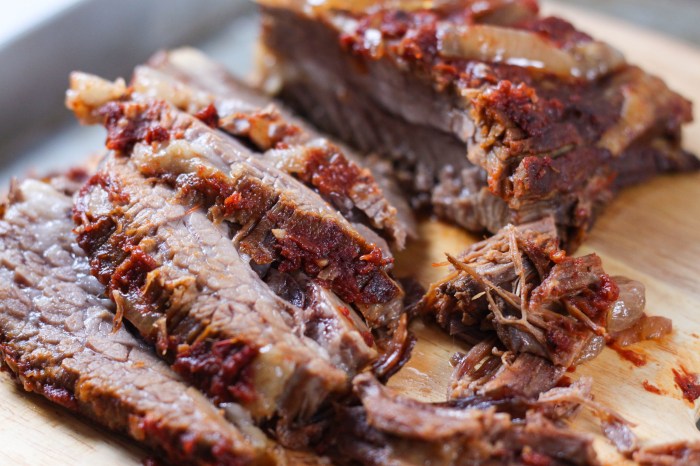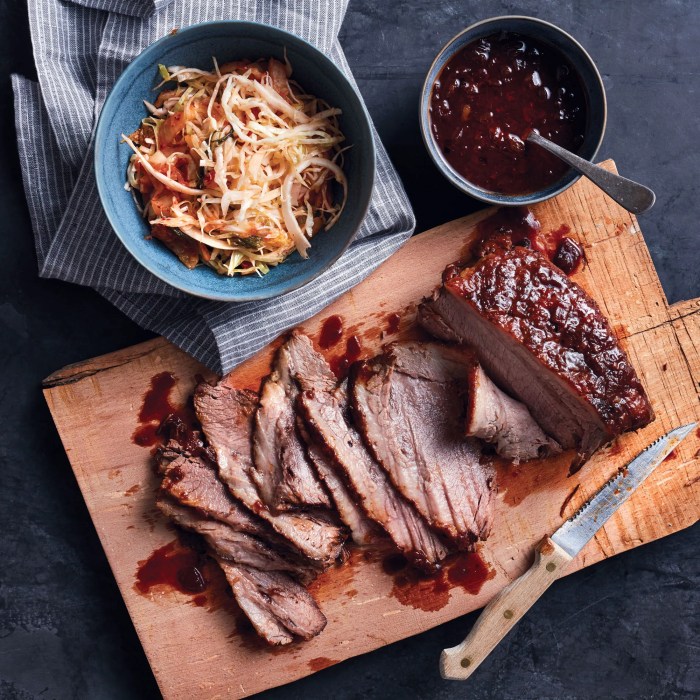Tips for Cooking Beef Brisket Korean Style

How to cook beef brisket korean style – When cooking beef brisket Korean style, it is important to marinate the meat for several hours to allow the flavors to penetrate. Use traditional Korean ingredients such as soy sauce, garlic, ginger, and sesame oil for an authentic taste. Slow cooking the brisket over low heat will ensure that the meat is tender and juicy.
What Does it Mean to Cook Beef Brisket Korean Style?
Cooking beef brisket Korean style means using a combination of sweet, salty, and savory flavors to create a delicious dish. The marinade typically consists of soy sauce, sugar, garlic, ginger, and sesame oil. The meat is then slow-cooked until it is tender and flavorful.
What is Known About Cooking Beef Brisket Korean Style?
Cooking beef brisket Korean style is a popular method in Korean cuisine. The dish is often served with rice and side dishes such as kimchi and pickled vegetables. The flavors of the marinade and slow-cooking process create a rich and savory dish that is enjoyed by many.
Solution for Cooking Beef Brisket Korean Style
To cook beef brisket Korean style, start by marinating the meat in a mixture of soy sauce, sugar, garlic, ginger, and sesame oil. Let the meat sit for several hours to allow the flavors to develop. Slow-cook the brisket over low heat until it is tender and juicy. Serve with rice and your favorite Korean side dishes for a complete meal.
Back in the traditional Batak style of cooking, one might be curious about how to cook Balbacua Davao style. This hearty and flavorful dish is a favorite among many, and learning how to prepare it can be a rewarding experience. If you’re interested in trying your hand at this delicious recipe, you can find a step-by-step guide on how to cook balbacua Davao style.
Detailed Information on Cooking Beef Brisket Korean Style
Cooking beef brisket Korean style requires patience and attention to detail. The key is to marinate the meat for several hours to infuse it with flavor. Slow-cooking the brisket over low heat is essential to ensure that the meat is tender and juicy. The traditional Korean marinade adds depth and richness to the dish.
Describing Beef Brisket Korean Style in Depth
Beef brisket Korean style is a delicious and flavorful dish that is popular in Korean cuisine. The marinade is the key to the dish, as it adds a unique combination of sweet, salty, and savory flavors. Slow-cooking the brisket allows the meat to become tender and juicy, making it a satisfying meal for any occasion.
Conclusion: How To Cook Beef Brisket Korean Style

In conclusion, cooking beef brisket Korean style is a rewarding experience that results in a flavorful and tender dish. By marinating the meat in a traditional Korean mixture and slow-cooking it over low heat, you can create a meal that is sure to impress. Serve with rice and your favorite Korean side dishes for a complete dining experience.
Frequently Asked Questions about Cooking Beef Brisket Korean Style

1. Can I use a different type of meat for this recipe?
Yes, you can try using different cuts of meat such as short ribs or pork belly for a variation of the dish.
2. How long should I marinate the brisket for?
It is recommended to marinate the brisket for at least 4-6 hours, but overnight for best results.
Have you ever wondered how to cook Balbacua Davao style? Learn the secrets of this delicious dish by following this step-by-step guide on how to cook Balbacua Davao style. Discover the traditional techniques and ingredients used to create this flavorful Filipino dish.
3. Can I cook beef brisket Korean style in a slow cooker?
Yes, you can use a slow cooker to cook beef brisket Korean style. Just adjust the cooking time accordingly.
4. What are some traditional Korean side dishes to serve with beef brisket?
Some traditional Korean side dishes to serve with beef brisket include kimchi, pickled vegetables, and steamed rice.
5. Can I adjust the level of spiciness in the marinade?
Yes, you can adjust the amount of red pepper flakes or gochujang in the marinade to suit your taste preferences.



